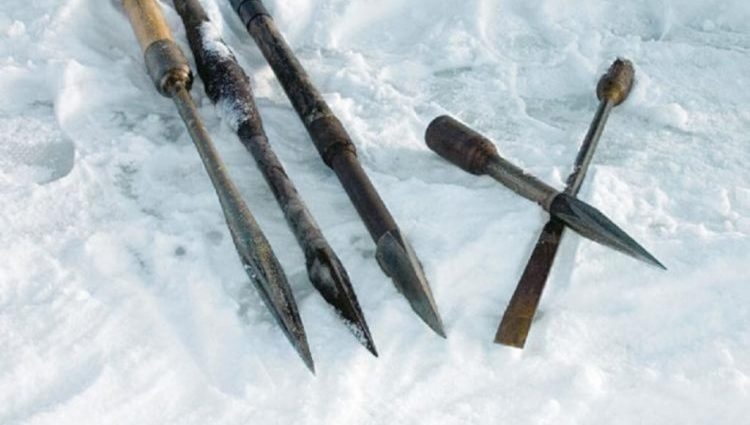Contents
With the advent of winter, many anglers begin to sort out equipment, review rods, and put the drill in order. The first ice is the most anticipated time, in which the mystery of the first steps along the thin edge, careful bites and large trophies is hidden. As a rule, a drill is not taken on thin ice; instead, the pick is the main tool for breaking holes.
Description and purpose
A pick is a winter tool that consists of two elements: a wooden base and a metal cutting part. All models differ in height, diameter, weight, length of the metal part. The end of the pick is usually pointed. Each product becomes dull over time, so it must be sharpened independently. This can be done with a stone or grinder.
The ice pick is used for winter fishing:
- with steep descents and ascents to the reservoir;
- for the first ice thickness test;
- as a tool for tapping the icy surface.
- for breaking through fishing holes;
- when expanding the hole for playing large fish;
- as a life-saving aid if it fell through the ice.
Typically, the length varies between 1-1,5 m. A tall tool is easier to control, since it does not require bending over in uncomfortable winter clothes to work with it. The sharp end and decent weight allow you to use the tool as a support. Often, after thaws, frost grows stronger, which leads to glaciation of the earth’s surface. It is much easier to move on how much ice with an ice pick.
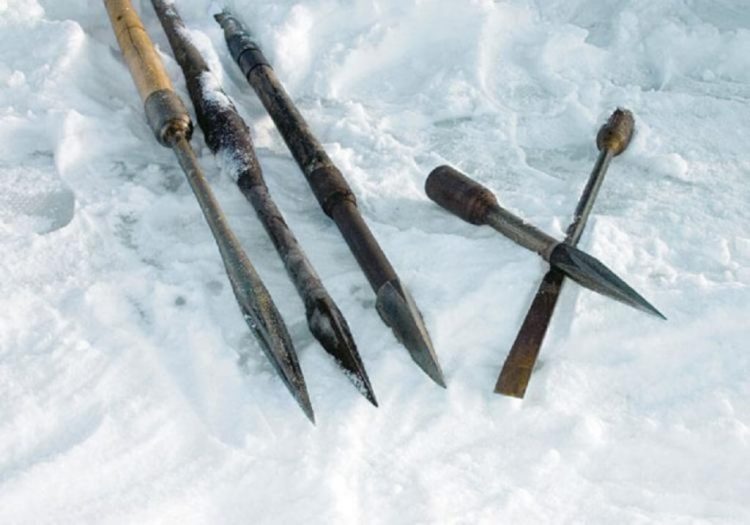
Photo: bo-volna.ru
Also, the tool serves as a support during ascents and steep descents, it is used when breaking through the first hole. If the ice breaks through from the first hit, then its thickness is insufficient to ensure the safe movement of the angler. Strong ice breaks through with 5 or more blows with the tip.
On the first ice, it is imperative to tap the water area in front of you, since the ice grows unevenly. This is especially noticeable in large reservoirs and rivers, where there is a current. In appearance, the frozen layer can be the same; its thickness can only be determined with a pick.
The hatchet, which is also used to break holes, is inferior in convenience and functionality. In order to make a hole, you need to kneel down, which in itself is unsafe. In severe frost, the wide plane of the ax can bring trouble to the fisherman. The fact is that upon impact, large cracks are formed, which thin ice does not tolerate. The pick strikes locally because its base has a small diameter.
Wood is used as materials for the handle:
- maple;
- linden;
- birch
- pine tree;
- oak.
The most comfortable products are made from birch, or rather, the outer radicular part of the trunk. The fact is that such a handle absorbs impacts on the ice, and the angler does not feel vibration in his hand. The structure of the wood dampens the vibration of the metal, which prevents the hand from getting tired during search fishing.
Some models are varnished, others are hewn to a perfectly smooth state. The varnished handles last longer, but they are inconvenient because the surface is slippery, especially when used with gloves. The height of the metal handle directly affects the weight of the product. As a rule, metal makes up 1/3 of the structure. The sharp edge has an extension, it is necessary for a greater capture of the ice area.
Ice pick and safety precautions
The pick is a multifunctional design that can be used in different fishing situations. One of the main advantages of the device is its length. You can get into the ravine not only at the beginning of winter. Many anglers “found” adventures in the dead of winter, when, it would seem, the ice can withstand the car. The undercurrent washes away the frozen mirror from below. A sharp change in temperature, constant thaws and precipitation in the form of rain make the ice brittle.

Photo: manrule.ru
The device helps not only to feel the reliability of the frozen coating, but also allows you to get out of the hole.
Once in the water, do the following:
- do not panic and act quickly;
- quickly find a solid surface;
- push off from it and crawl out onto the ice;
- rolling to move towards the coast.
An emphasis can be made with a pick if the hole is not wide. With the help of such an emphasis, it is easier to get out onto the ice. If the hole is wide, you need to let go of the tool, because it sinks and adds weight to the angler. In icy water without special equipment, the angler has 40-60 seconds before his hands begin to go numb. During this time, you need to decide how to get out and do your best.
Also, the fisherman who came to the rescue can use the ice pick. The main thing to remember is that you can’t go close to the polynya, you should quickly check with blows where the ice is strong. In this case, the pick is used as a rope, if one is not at hand.
It is better to transport the pick in a case, keeping the wood from excess moisture. Also in the case the device is stored in the summer.
Pros and cons compared to a brace
An ice drill is a professional device that is used by anglers everywhere. However, the drill is not always the best option for fishing. In many cases, it is better to give preference to the classic pawn.
Advantages of a pawn over a rotator:
- low cost;
- assistance in moving on slippery surfaces;
- overcoming climbs;
- expansion of the hole for lifting the trophy;
- fast penetration of old holes;
- safety on the first ice.
The ice pick has many advantages, it is used in a whole list of cases. Without a certain skill, it is almost impossible to drill a finished hole with an ice drill. It is important to maintain the angle, do everything gradually and not touch the line. Reaming a hole sooner or later will come in handy for every angler. Sometimes in winter you come across a large fish, such as bream, pike, perch, and stretching it into a narrow hole will not work according to the laws of physics.
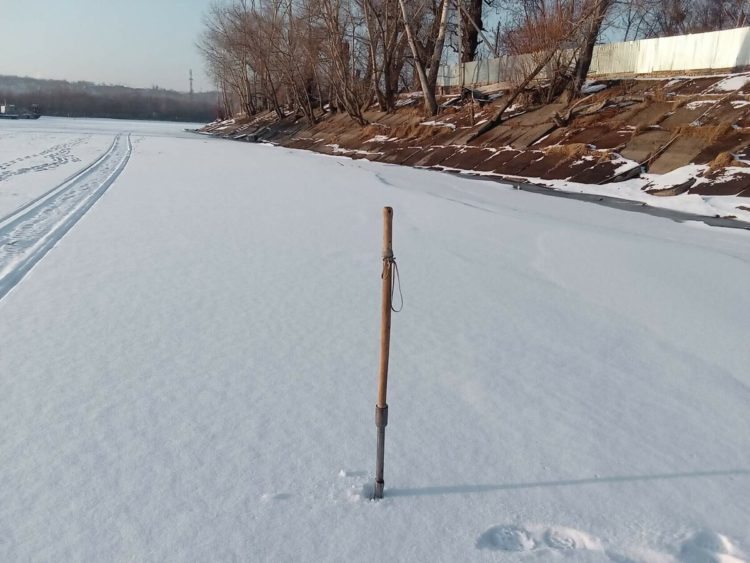
Photo: avatars.mds.yandex.net channel “Urban fisherman…”
Ice breaking is the easiest way. This can be done even alone by letting go of the trophy lower and pressing the line to one edge of the hole. Also, a pick in February will not be superfluous, when the reservoirs are literally drilled up and down. Many holes have been abandoned for a long time, so anglers prefer to look for bream in already prepared holes.
You should not occupy other people’s holes when there are clear signs of the presence of an angler on the ice. You can only fish in abandoned areas, especially a lot of them after the weekend.
The old holes do not have time to grab the thick ice, so they break through with a pawn in a few hits. Of course, you can use a drill for this purpose, but rotator manufacturers do not welcome drilling through old holes. This spoils both the knives and the auger, and if you are not careful, you can quickly break the cutting part.
The disadvantages of the ice pick include:
- time-consuming breaking through of ice from 10 cm;
- impossible to use on a thick frozen mirror;
- the cost of great effort compared to the drill;
- the weight of the instrument to be carried.
Many anglers take both a drill and an ice pick with them, but it is extremely difficult to move around with a full inventory on a snowy pond, and even in winter clothes. Due to the metal tip, which sometimes reaches half of the product, the pick weighs a lot.
The tool is not suitable for breaking through thick ice, because it takes a lot of time and effort to make one hole.
How to choose a ice pick for ice fishing
Before choosing a pawn, you need to decide on the budget, model and other nuances. The device consists of a handle, a tip and a glass. Often, the ice pick gets wet during fishing, the tree absorbs moisture, and when it gets into heat, it shrinks. Because of this, the stalk slips out or sits freely in a metal glass.
Before buying, you should pay attention to the height of the device and separately to the length of the metal tip. The handy pick is shoulder-length to allow the hand to rest freely on the top of the knob. Due to the different heights of anglers, the design should be selected individually. Some anglers use shortened models, their length falls to the waist. You can cut a hole with such a device with one hand.
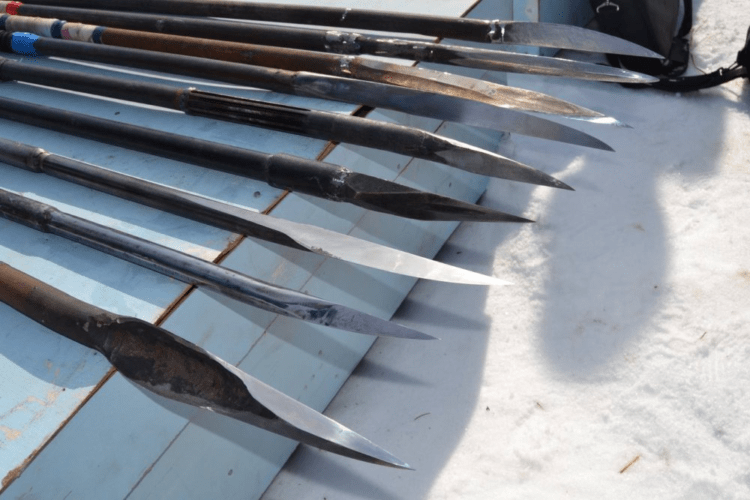
Photo: avatars.mds.yandex.net channel “fishermen7777”
The thickness of the cutting also plays an important role. A thin tree slips out of the grip in exactly the same way as a thick one. You need to try on the thickness in gloves used in fishing during transitions.
Many products have a through hole through which a rope is threaded. With the help of a rope ring, it is easy to carry devices from place to place, dragging it along with you.
The length of the metal should be no more than 30-40 cm. Otherwise, the weight of the product will be too large and it will become uncomfortable to work with such a pawn.
Another important feature is the shape of the glass. A high-quality pick has holes in it to let excess moisture out. To prevent the ice pick from drying out, store it in the cold, for example, on a balcony or in a garage.
A light tool has a weight of about 2-2,5 kg. These are usually short cuts. The long pick has a weight of up to 3,5 kg. Structures above this value are only used to break through very thick ice. They are used by fishermen.
The tip is of different types:
- bit;
- peak;
- saber;
- petal;
- scapula.
An important requirement for the tip: the tip must always be sharpened. A dull pick will only bring frustration and inconvenience while fishing, so you can carry a small grindstone with you.
Sticks with wedge-shaped tips allow you to make a hole with an extension at the top. Models with a chisel-shaped tip allow you to make the hole even.
Also on the fishing shelves you can find monolithic or collapsible products. Which model is better is up to each angler to decide for themselves. After all, monolithic ice picks do not require effort to disassemble in the cold. Devices with a connecting part often freeze and have to be disassembled at home.
The best models for ice fishing
Many anglers use old Soviet ice picks, which are difficult to work with due to their heavy weight. Modern devices are factory and homemade. And here and there there are worthy models that will help out on any fishing trip.
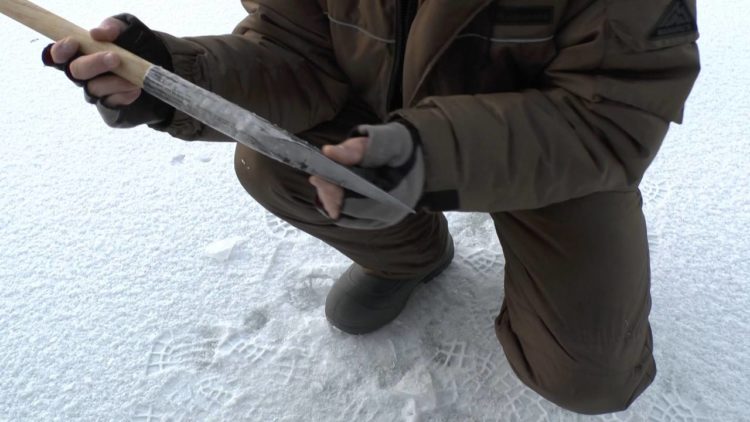
Photo: activefisher.net
One of the best collapsible devices is considered to be a model from the Tri Kita company. In its production, lightweight materials are used, providing an incredibly low weight – only 680 g. In working condition, the model has a length of 1,5 m, in the assembled – 0,86 m.
Also on the fishing market you can find combined models, such as the Rodstars pick, which includes a hook. The advantage of this option is additional features. With the help of a hook, you can move large ice floes or get fish out of the hole. Such models are in demand when catching crabs, in commercial fishing, as well as amateur ice fishing.
The handle of the model consists of two parts, is painted in bright orange and weighs about 1,3 kg. The top has a comfortable rubber grip. The same one is near the base.
In addition to foreign brands, domestic manufacturers also bring their products to the market. For amateur anglers, Tonar presents its product, which consists of three parts. The handle is made of wood, at the bottom there is a sharpened point in the form of a step. A reliable pick harmoniously combines wood and metal, has a dense rubber band on the cutting part.
Choosing a pawn is not an easy task, for which you need to carefully prepare. It is important that the ice tool fits snugly in the hand, does not slip out and does not burden the hand. A quality product will not only bring comfort to fishing, but also help in case of dangerous situations on the ice.










